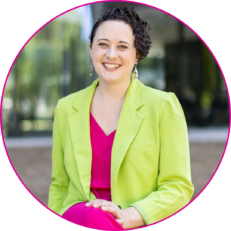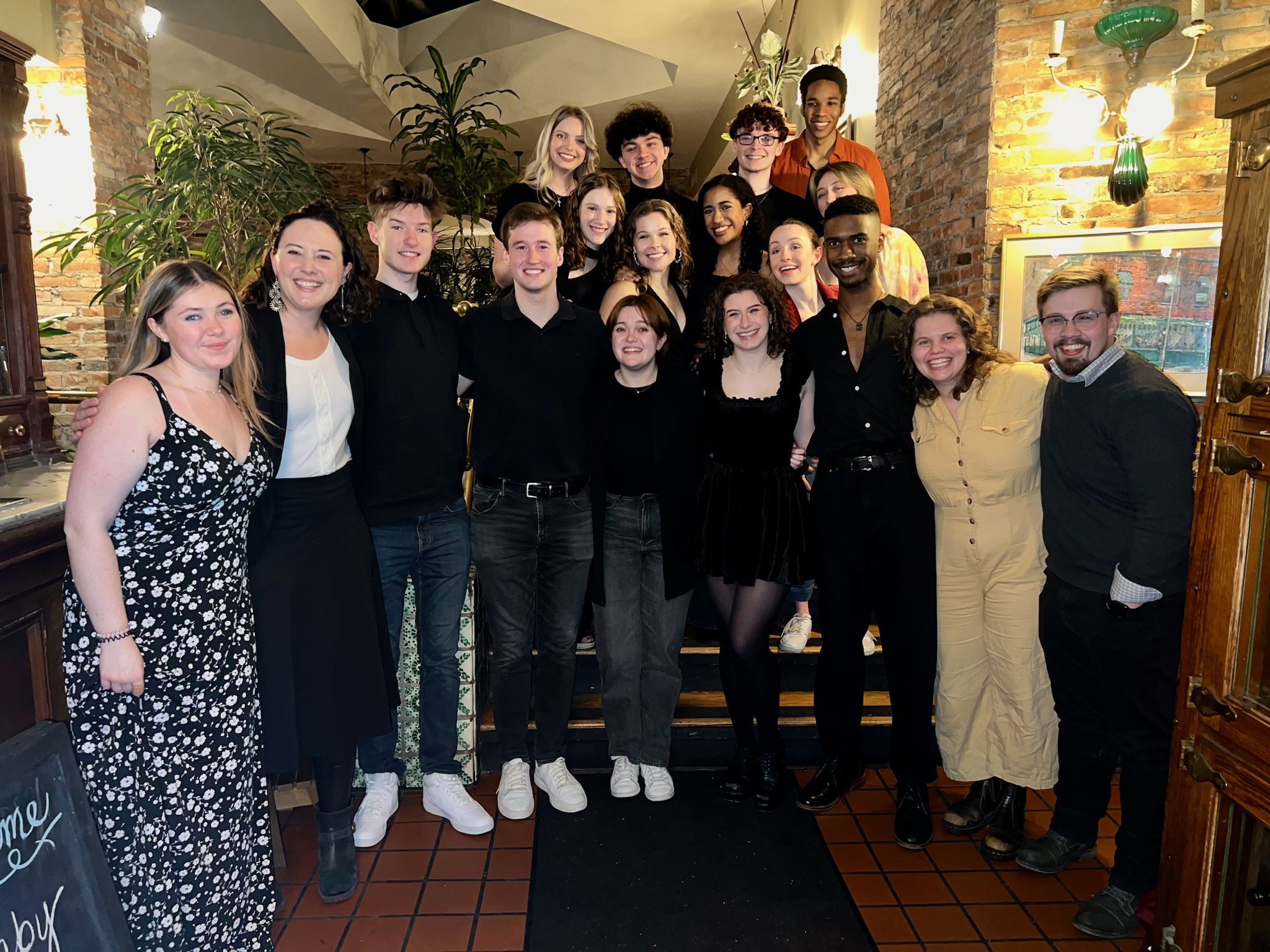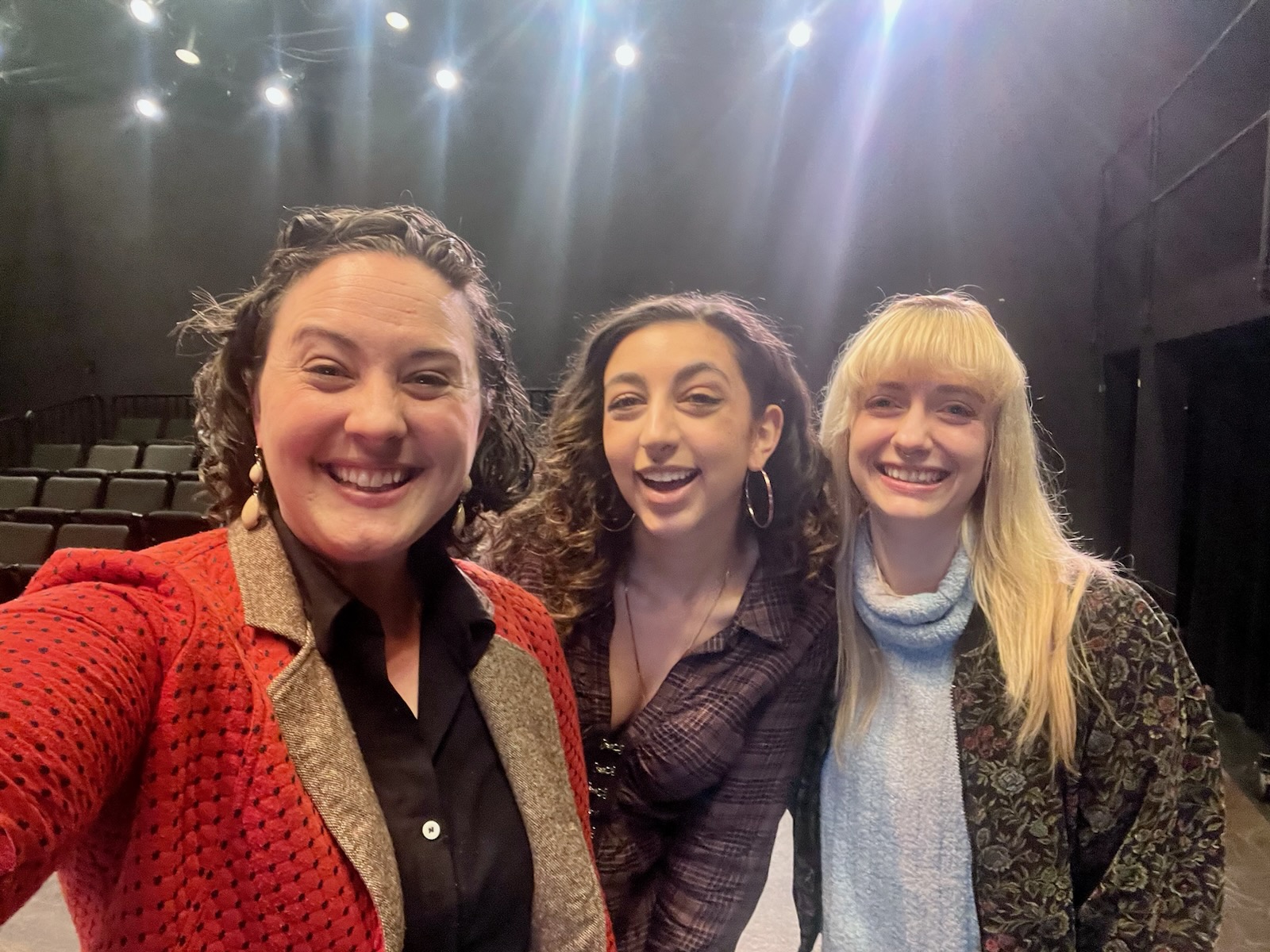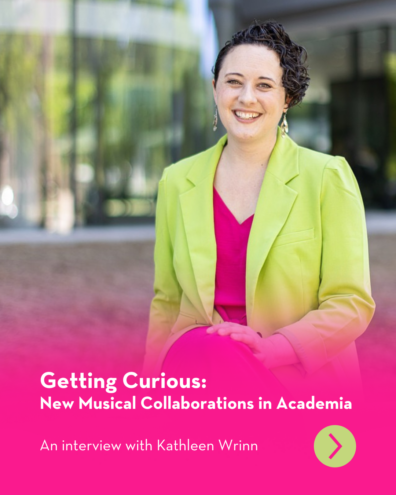 As Kathleen Wrinn steps into her new role as Co-Chair of NAMT’s Festival Committee, she continues to shape the future of new musicals—both in the classroom and on the stage. From leading Syracuse University’s New Works/New Voices initiative to co-authoring a practical guide for developing musicals in academic settings, Kathleen is championing emerging voices, fostering collaboration and redefining how new work is nurtured in university theatre programs.
As Kathleen Wrinn steps into her new role as Co-Chair of NAMT’s Festival Committee, she continues to shape the future of new musicals—both in the classroom and on the stage. From leading Syracuse University’s New Works/New Voices initiative to co-authoring a practical guide for developing musicals in academic settings, Kathleen is championing emerging voices, fostering collaboration and redefining how new work is nurtured in university theatre programs.
NAMT:
You wear so many hats! How do they—
Kathleen Wrinn:
Intersect? I do wear many hats! I am an educator, a performer, a writer (a lyricist and bookwriter, primarily, but I also compose), and in the past few years, I’ve also been directing and serving as a story consultant/dramaturg on the various musicals that come through New Works/New Voices at Syracuse. So, the question of how they all intersect: I always try to approach each role with a sense of collaboration. Even when I work with my students, whether one-on-one or in a group studio setting, I encourage us to put our heads together to figure out how we can move the work forward. I’m also big on peer-to-peer feedback, framing each class as a conversation and asking the questions: What is the artist trying to achieve? What is the audience receiving? How could the storytelling be made clearer or more impactful? So, when I think about how I approach my work in musical theatre, the short answer is, I always work with other people. That’s the common thread. I try to put myself in spaces where I get to bounce my own ideas off other passionate, creative, brilliant people. Even with the book that I’m writing, that’s how I work. It’s rarely just me, and I love that.
NAMT:
Are there other values in your experience as an educator that guide your new works process?
KW:
Curiosity! I try to foster that among my students, both curiosity about their characters and about material that is still evolving. For instance, I’m teaching an upper-level performance course right now called “Workshopping New Musicals.” My goal with the course is to teach students how to be the kind of performers that writers want to work with. We’re currently doing a unit on how to engage with storylines that perhaps don’t fully make sense, or with characters that are still being discovered—where there’s maybe a glimmer on the page of who they are, but their arcs aren’t fully fleshed out yet. One of the guiding tenets I tell students in my class is to get curious, not critical, whenever there’s a question that they come up against, or a confusion, or even a frustration. I want them to develop the habit of asking themselves, “What choice could I make as an actor that could support and enliven what’s currently on the page?” Or, “What might be the reason the writers made this choice?” as opposed to assuming it shouldn’t be that way. Cultivating that sense of curiosity in myself and in my students—the impulse to ask why, rather than immediately prescribing your own solution—that’s a big value in my work.

NAMT:
You founded New Works/New Voices at Syracuse University’s Department of Drama. Talk to us about what it was like launching this initiative?
KW:
Sure! New Works/New Voices (NWNV) is an initiative that supports the development of musicals by writers and composers whose perspectives have been historically underrepresented in the musical theatre canon. When I started my full-time position at Syracuse in 2020, I knew I was going to be involved in season planning and directing. Given my background, it’s probably no surprise that I was eager to see us tackle new musicals—not just shows that are contemporary, but musicals that are still in-process, particularly by creators from historically marginalized communities. Something I quickly realized, however, was that since I was no longer living in New York City, it was difficult for me to keep my finger on the pulse of what was being created. (Since that time, there have been various databases of new works launched, such as the New Works Collaboration Catalog through Musical Theatre Educators’ Alliance, and an upcoming Directory of Shows at MaestraMusic.org, both of which I helped co-create, but those didn’t exist back then.) I realized that, if we were going to produce new works at Syracuse, we needed to find a way to have those works come to us, so I sought support through an internal grant from the university and launched NWNV in 2021. Since then, NWNV has been absorbed into the Department of Drama’s regular production season, and we’re now committed to doing it every Spring, which I’m very proud of.
Each year, we put out a call for submissions, and I then work with a committee of student readers to select the work(s) to be produced. I designed a multi-step evaluation process for NWNV, which, funnily enough, has many similarities to the NAMT Festival selection process, which I later discovered after getting involved with NAMT last year. During the selection process, I facilitate the committee’s conversations as the students think through which work(s) we will select. What are the developmental needs of the shows? What kind of stories do we feel we can support? What excites us? Initially, I didn’t realize how meaningful this aspect of the process was going to be, but allowing the students’ perspectives to have so much influence on what we end up producing is now a core value of the initiative. At the end of the selection process, one musical is chosen to receive a three-week developmental workshop in the Spring, directed and music directed by SU Drama faculty and performed by our students, with the writers in residence for two of those three weeks. This year, in addition to the three-week workshop, we’re also doing a 29-hour reading of a second new work.
NAMT:
Alongside Alisa Hauser, Assistant Professor of Music Theatre at Florida State University, you are co-authoring Developing New Musicals in University Theatre Programs: A Practical Guide. Tell us what educators and musical theatre developers can expect from this new book.
KW:
Alisa and I are endeavoring to write the book we wish we’d had when we each started our own new musicals initiatives at our universities. When you are an educator leading a new work process with both professional writers and pre-professional students who are still learning their craft, there are unique opportunities and challenges that emerge from that dynamic. Our goal is to create a practical resource for educators who are embarking on developing new musicals for the first time—at any stage of the process, a reading, a workshop, a full production—as well as those who are already engaged in this work and are looking to refine their own creative and collaborative practices.
Circling back to the theme of collaboration, we didn’t want the voices in the book to be just our own, so we conducted extensive interviews with faculty in the US and abroad who lead new musicals programs, as well as with writers and composers who have developed their works at universities, and even with students who have participated in these processes. With every person we’ve interviewed, we’ve asked: What has worked well? What has been challenging? What best practices are important to keep in mind when structuring and facilitating such a process, so writers, students, and faculty members alike can feel equipped with the tools to succeed? It’s tough answering some of these questions on your own, so our hope, in creating this book, is to be the colleagues you can talk to who have done this work before and can be there to support you.
NAMT:
What are the unique opportunities and challenges while developing new musicals in an academic setting?
KW:
I’ll speak first to the opportunities. One thing I love about NWNV is that it allows the writers ample time to focus on rewriting, by providing a low-stakes space for creative experimentation. During the three-week workshop, the creators get to try out both little changes and big changes and then see how those changes resonate with an audience. We’re not under the pressure of needing to mount the whole show in a week, we’re not paying for the rehearsal space, the investors aren’t coming on opening night. This type of process-focused environment is something that is often rare in the industry, but that’s really the wonderful gift academia can give to new musical development.
In terms of the challenges, as you know, new musical development is such a highly collaborative endeavor that it’s easy for toes to get stepped on, particularly when you’re working in an environment with professional writers and pre-professional students who are still developing their own skillsets, their own tools, and who may never have been in the same room with living writers before! This is a big theme in our book, but obviously, you cannot avoid every challenge. Things will come up. However, many issues can be skirted, or at least mitigated, if you establish common goals and clear expectations up front and foster open channels of communication.
When you’re working on a new musical in a university, it’s important to remember that there are two things being developed at once: the new work and the students themselves. Both are works-in-progress, and there’s a ton of energy being poured into both as they each figure out who they are and who they want to be. Sometimes it takes a student a little time to grow into a new role, particularly when there’s no prior interpretation to model on. As educators, we often encourage our students, “let yourself fail, let yourself try something big and find out if it works!” But the same goes for the writers. They’re also trying to figure it out, trying to get their ideas to stand on their own two feet, and they need to be given the space and trust to do so. It’s important that students learn how to collaborate with the writers during this process of discovery without trying to write the piece for them, and for the writers to remember that the students are still learning. Grace and patience need to be given in both directions, and in my experience, they often are, and that’s when really exciting things start to happen. Suddenly, a student comes in one day and takes a big swing at something that they’ve never done before, and it just shocks everybody, and then the writers do the same thing the next day with new pages. It’s moments like these that make a new musical rehearsal room in academia one of the most artistically thrilling and inspiring places to be.

NAMT:
How do you see the role of universities evolving in new musical development as you go forward? What do you hope for their future?
KW:
I want to see more partnerships. As you know, I don’t like creating anything alone! My hope is for more partnerships to be formed—both between universities, as well as between universities and professional theatres. I think about this a lot, because Syracuse University is in the same building with Syracuse Stage, Central New York’s premier regional theatre, and we have such a rich, 50-year symbiotic partnership. Each organization in the musical theatre landscape, whether it’s a regional theatre or a college, has something useful it could strategically offer in the developmental pathway of a new musical. Right now, it’s a difficult time for professional theatre companies to take risks, but this is where universities can step in. University theatre department budgets are (often) unrelated to ticket sales, and we also have the luxury of time, which is such a priceless resource in new musical development. This semester, in addition to NWNV, I’m teaching a 15-week course at Syracuse in which we’re developing two other new musicals. Universities can provide this type of experimental playground where early development can take place. And this isn’t a selfless thing on our parts, either! Doing this work benefits our students. It teaches them about collaboration, about process, about the professional skills needed to make it in the field. So many of them are going to get hired on new musical development projects right after they graduate. It’s a practical skill. It’s also just a good life skill. How do you work with other people?
NAMT:
What role do you see Membership Organizations like NAMT, the Musical Theatre Educators’ Alliance and Maestra Music playing in the future of new musical development, particularly for academic institutions? What do you hope for the artists supported by them?
KW:
Resource-sharing is huge. My hope is that if there’s someone, somewhere, who wants to develop a new work, they can find community and support around that idea. If we want to make the new musical ecosystem one of abundance and not of scarcity, it’s not going to be changed by one program or even one large organization. NAMT can’t just change it, let alone one drama department in Upstate New York. It has to be a collaborative, systemic change. Part of creating widespread change is giving everyone access to the same resources, so they can then take up the mantle in their own communities and institutions. That’s one thing membership organizations can do.
They can also lead by example—by which kinds of works they choose to produce, which artists they decide to shine a light on. I think about that responsibility with New Works/New Voices all the time. Creating new opportunities is important, but so is spreading around those opportunities that already exist. This is a tricky conversation to have, I know, but as a writer myself, I understand how getting or not getting an opportunity can mean the difference between sticking with a project and giving up on it for good. Musicals take a long time to create! Hearing that one “yes” when you were about to throw in the towel is critical to helping writers hang on to reach the finish line.
And I really do think abundance is attainable, particularly in academia. There are close to 400 theatre-degree granting programs at universities in the United States, and over 200 of those have a musical theatre concentration or degree. What if all those universities worked on a new musical every year? What if even half of them did? How many more of these works and artists would have the opportunity to take that next step forward? I want to see more chances taken every year on new works, on new voices, by new organizations. I want to see more people get more opportunities. That’s my biggest hope.

Kathleen Wrinn is an Assistant Professor of Musical Theatre at Syracuse University’s Department of Drama where she is also the founder and Artistic Director of SU Drama’s new musicals developmental initiative, New Works/New Voices. She is also the Directory Manager for MaestraMusic.org and Co-Chair of the Musical Theatre Educators’ Alliance (MTEA) New Works Subgroup where she co-created the New Works Collaboration Catalog. Her book with Alisa Hauser, Developing New Musicals in University Theatre Programs: A Practical Guide, is under contract with Bloomsbury Publishing | Methuen Drama and anticipated to be published in early 2026. At NAMT, Kathleen is a Co-Chair of the Festival Committee for the Annual Festival of New Musicals.
To find out more about New Works/New Voices, visit www.kathleenwrinn.com/new-works-new-voices.

